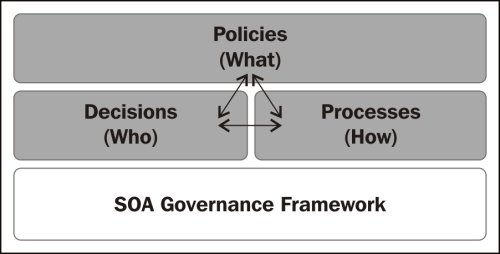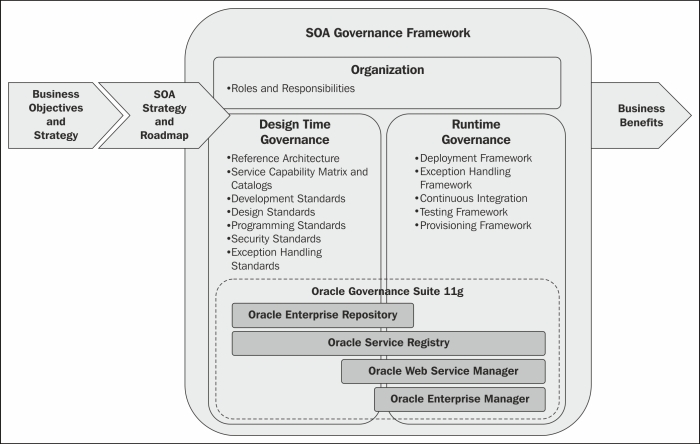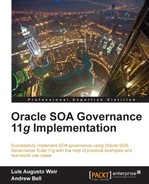The answers to these questions, together with the concepts and tooling outlined in this book, provide the foundation for implementing a robust SOA Governance framework that underpins an end-to-end SOA ecosystem.

An SOA Governance framework defines the approach, artifacts, processes, tools, and people required to implement governance.
Having an effective and strong SOA Governance framework in place is extremely important as it delivers a common and consistent language for the enterprise to define and manage semantics, processes and standards, and accountability for an entire SOA lifecycle.
Indeed, without a well-defined SOA Governance framework, it is highly likely that the members of an organization, or its partners, will have their own understanding of what SOA represents and how it is best implemented, leading to misalignment and duplication of effort across departments and between the collaborating organizations. In large and complex SOA implementations, this situation leads to poor implementations and, almost inevitably, failure to deliver meaningful SOA.
Without implementing a strong and well-defined SOA Governance, underpinned by a robust SOA Governance framework, an enterprise-wide SOA implementation will almost certainly fail to achieve the true promise of SOA and the subsequent benefits that ensue.
An SOA Governance framework defines the roles, responsibilities, processes, and procedures (what-how-who) that are needed to enforce the governance of all aspects of the service lifecycle (what-how-who). An SOA Governance framework is imperative for the success of an SOA implementation.
This book sets out to discuss the tooling and concepts provided by Oracle Corporation to achieve successful SOA governance. The following diagram depicts in more detail what an SOA Governance framework would look when put into context of the Oracle SOA Governance solution. We will explore the concepts illustrated in the following diagram throughout this chapter, showing how each contributes to the overall framework:

The preceding diagram shows how the business objectives and strategy are the fundamental drivers of an SOA Governance implementation. Without a clear focus on the business drivers and on how SOA can help achieve these business goals, an SOA implementation will most likely fail to deliver and end up being perceived by the management as yet another expensive technology that adds little value.
SOA Governance, on the other hand, helps to define metrics that can be used to demonstrate how SOA is being effectively utilized and to measure the tangible benefits to the business.
Prior to the introduction of SOA Governance into an organization, an SOA Strategy and a clearly defined SOA Roadmap should be defined as illustrated in the following diagram:

In order to ensure that SOA Governance is achieving real business benefits, it is imperative to understand the objectives of an SOA Governance implementation.
Understanding the business goals and business strategy will dramatically improve the chances of success for an SOA implementation. Equally, and as said earlier, without clear objectives an SOA implementation can be perceived as failing to deliver measureable benefits to the business.
When defining the objectives for an SOA Governance implementation, one should bear in mind that all objectives should be supported by clear success factors that are achievable and measurable prior, during, and after the implementation.
The following principles should be followed when defining the objectives of an SOA Governance implementation (Introducing Oracle SOA Governance, Oracle Corp. 2008):
- Business value: Ensuring that the project investments yield business value
- Alignment: Keeping the SOA aligned with the business and its architecture, and in compliance with the business and IT policies
- Business agility: Gaining visibility into your SOA for more rapid decision making
- Risk reduction: Controlling dependencies, managing the impact of change, and enforcing policies
- Cost savings: Promoting consolidation, standardization, and reuse
Once the objectives have been defined, these should be well-documented and presented to the key stakeholders within the business and IT departments to obtain the desired level of sponsorship. This sponsorship is critical to achieve the required level of assistance from different departments in order to elaborate the maturity assessment and roadmap, and to secure any extra funding if needed.
